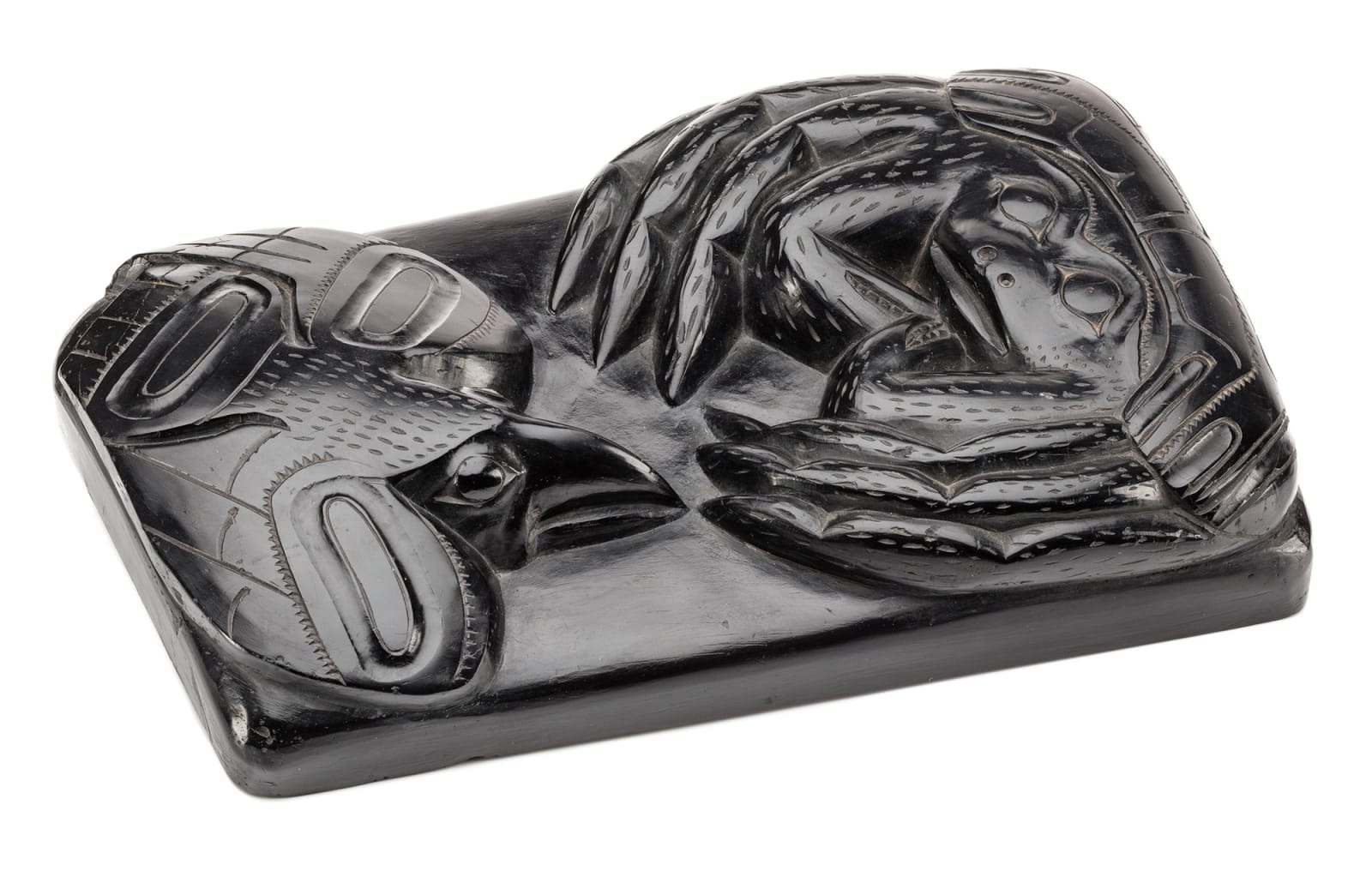-
Artworks
UNIDENTIFIED HAIDA ARTIST
Raven and Crab Plaque, c. 1880sargillite, 2 x 9 x 5.5 in (5.1 x 22.9 x 14 cm)Lot 124
ESTIMATE: $6,000 — $9,000
PRICE REALIZED: $4,800.00Further images
This work appears primarily to illustrate a story, that of an encounter between a raven and a mythical large crab. A slab of argillite is carved on one side with...This work appears primarily to illustrate a story, that of an encounter between a raven and a mythical large crab. A slab of argillite is carved on one side with high-relief figures of a raven with outspread wings and a crab with stylized shell and legs. The slab appears to have no function other than display, as the bottom is flat and shows no signs of fitting onto anything else, as a lid would.
The bird is posed with wings outstretched, as if flying down to meet the crab. Between the wings is the broad tail of the raven, and like the wings, it’s composed of a large formline ovoid with elements attached to represent feathers. The back of the head and body are textured in rows, also to represent feathers. The crab is quite large by comparison to the raven. Its legs are textured with small scoop cuts randomly placed. This distinguishes six legs and two claw-feet. The two clawed appendages are turned at different angles, giving them a more spontaneous appearance. The crab’s face is centered, and shows a pair of eyes, two small nostrils and a mouth. Above the face the crab’s shell arches across the head, with design elements setting it off from the rest of the creature.
Steven C. Brown
John R. Swanton recorded numerous Haida myths in 1900-01. The account of Raven’s travels included this telling by the Chief of Kloo of Those-born-at-Skedans: “And when [Raven] went away he came to where a spider crab sat. And he said to it: ‘Comrade, do you sit here? Don't you know that we used to play together as children?’ He then put his wings into its mouth and took them out again. ‘A little farther off, spider crab,’ he said to it, and it closed its jaws together. It began at once to move seaward. And he (Raven) said to it: ‘Comrade, let me go. When about to let me go you used to look at me with eyes partly closed [as you are doing] now. Let me go. It will be better for us to play with each other differently. Let me go.’ By and by the sea water flowed over him. Then it let him go.” [2] A very similar plaque in the Reif Collection at the Royal B.C. Museum is illustrated in Macnair & Hoover’s book The Magic Leaves, p. 163.
1. In his 1886 book Wonderland; or, Alaska and the Inland Passage, Schwatka writes that the wares in “curio shops” in Victoria, B.C. include: “Curiously carved steatite houses, in miniature imitation of the Indian dwellings, and "totem poles" made by the Hydah or Haida Indians, are to be seen for sale. Sometimes they carve plaques with spread-eagles and other fanciful designs upon them…” (p. 54).
2. John R. Swanton, Haida Texts and Myths: Skidegate Dialect (Washington, Smithsonian Bulletin 29, 1905), 128.
References: For a very similar plaque see Peter L. Macnair and Alan J. Hoover’s The Magic Leaves: A History of Haida Argillite Carving, (Victoria: Royal British Columbia Museum, 1984/2002), fig. 172, p. 163.
Provenance
Collected by Frederick Schwatka (1849-1892), M.D., Arctic explorer and cavalry officer;
Skinner Auctions Boston, MA, 23 Sep 2007, Lot 215;
A Vancouver Collection. [1]
Join our mailing list
* denotes required fields
We will process the personal data you have supplied in accordance with our privacy policy (available on request). You can unsubscribe or change your preferences at any time by clicking the link in our emails.








